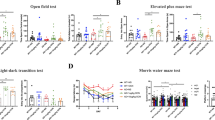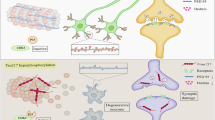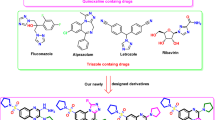Abstract
Alzheimer’s disease (AD) is the most prevalent neurodegenerative disorder characterized by cognitive impairments. Despite the limited efficacy of current treatments for AD, the 1,2,4-oxadiazole structure has garnered significant attention in medicinal chemistry due to its potential impact on mGluR1 and its association with AD therapy. In this study, a series of novel 1,2,4-oxadiazole derivatives were designed, synthesized, and evaluated for the neuroprotective effects in human neuroblastoma (SH-SY5Y) cells. Among all the derivatives tested, FO-4-15 (5f) existed the lowest cytotoxicity and the highest protective effect against H2O2. Based on these in vitro results, FO-4-15 was administered to 3×Tg mice and significantly improved the cognitive impairments of the AD mice. Pathological analysis showed that FO-4-15 significantly reduced Aβ accumulation, Tau hyper-phosphorylation, and synaptic impairments in the 3×Tg mice. Dysfunction of the CaMKIIα/Fos signaling pathway in 3×Tg mice was found to be restored by FO-4-15 and the necessity of the CaMKIIα/Fos for FO-4-15 was subsequently confirmed by the use of a CaMKIIα inhibitor in vitro. Beyond that, mGluR1 was identified to be a potential target of FO-4-15, and the interaction of FO-4-15 and mGluR1 was displayed by Ca2+ flow increase, molecular docking, and interaction energy analysis. The target of FO-4-15 was further confirmed in vitro by JNJ16259685, a nonselective inhibitor of mGluR1. These findings suggest that FO-4-15 may hold promise as a potential treatment for Alzheimer’s disease.
This is a preview of subscription content, access via your institution
Access options
Subscribe to this journal
Receive 12 print issues and online access
$259.00 per year
only $21.58 per issue
Buy this article
- Purchase on SpringerLink
- Instant access to full article PDF
Prices may be subject to local taxes which are calculated during checkout









Similar content being viewed by others
References
Cuestas Torres DM, Cardenas FP. Synaptic plasticity in Alzheimer’s disease and healthy aging. Rev Neurosci. 2020;31:245–68.
Hampel H, Mesulam MM, Cuello AC, Farlow MR, Giacobini E, Grossberg GT, et al. The cholinergic system in the pathophysiology and treatment of Alzheimer’s disease. Brain. 2018;141:1917–33.
2023 Alzheimer’s disease facts and figures. Alzheimers Dement. 2023;19:1598–695.
Loera‐Valencia R, Cedazo‐Minguez A, Kenigsberg PA, Page G, Duarte AI, Giusti P, et al. Current and emerging avenues for Alzheimer’s disease drug targets. J Intern Med. 2019;286:398–437.
Luo ZH, Wang YC, Pang S, Gao S, Liu N, Gao X, et al. Synthesis and bioactivity evaluation of a Novel 1,2,4-Oxadiazole derivative in vitro and in 3×Tg mice. Drug Des Dev Ther. 2022;16:3285–96.
Masters CL, Bateman R, Blennow K, Rowe CC, Sperling RA, Cummings JL. Alzheimer’s disease. Nat Rev Dis Prim. 2015;1:15056.
Kaushik M, Kaushik P, Parvez S. Memory related molecular signatures: The pivots for memory consolidation and Alzheimer’s related memory decline. Ageing Res Rev. 2022;76:101577.
Su LD, Wang N, Han JH, Shen Y. Group 1 Metabotropic Glutamate receptors in neurological and psychiatric diseases: mechanisms and prospective. Neuroscientist. 2022;28:453–68.
Dal Prà I, Armato U, Chiarini A. Family C G-protein-coupled receptors in Alzheimer’s disease and therapeutic implications. Front Pharmacol. 2019;10:1282.
Ferraguti F, Crepaldi L, Nicoletti F. Metabotropic glutamate 1 receptor: current concepts and perspectives. Pharmacol Rev. 2008;60:536–81.
Hendawy OM. A comprehensive review of recent advances in the biological activities of 1,2,4‐oxadiazoles. Arch der Pharmazie. 2022;355:e2200045.
Biernacki K, Daśko M, Ciupak O, Kubiński K, Rachon J, Demkowicz S. Novel 1,2,4-Oxadiazole derivatives in drug discovery. Pharmaceuticals. 2020;13:111.
Pang S, Li SY, Cheng HZ, Luo ZH, Qi XL, Guan FF, et al. Discovery of an evodiamine derivative for PI3K/AKT/GSK3β pathway activation and AD pathology improvement in mouse models. Front Mol Neurosci. 2023;15:1025066.
Oddo S, Caccamo A, Shepherd JD, Murphy MP, Golde TE, Kayed R, et al. Triple-transgenic model of Alzheimer’s disease with plaques and tangles. Neuron. 2003;39:409–21.
Webster SJ, Bachstetter AD, Nelson PT, Schmitt FA, Van Eldik LJ. Using mice to model Alzheimer’s dementia: an overview of the clinical disease and the preclinical behavioral changes in 10 mouse models. Front Genet. 2014;5:88.
Du F. Golgi‐Cox staining of neuronal dendrites and dendritic spines with FD Rapid GolgiStain™ Kit. Curr Protoc Neurosci. 2019;88:e69.
Pang S, Luo ZH, Dong W, Gao S, Chen W, Liu N, et al. Integrin β1/FAK/SRC signal pathway is involved in autism spectrum disorder in Tspan7 knockout rats. Life Sci Alliance. 2022;6:e202201616.
Dunaevsky A, Risher WC, Ustunkaya T, Singh Alvarado J, Eroglu C. Rapid Golgi analysis method for efficient and unbiased classification of dendritic spines. PLoS One. 2014;9:e107591.
Gao Y, Pei C, Sun XY, Zhang C, Li L, Kong XR. Plasmid pcDNA3.1-s11 constructed based on the S11 segment of grass carp reovirus as DNA vaccine provides immune protection. Vaccine. 2018;36:3613–21.
Konno T, Melo EP, Chambers JE, Avezov E. Intracellular sources of ROS/H2O2 in health and neurodegeneration: spotlight on endoplasmic reticulum. Cells. 2021;10:233.
Chen C, Xu D, Zhang ZH, Jia SZ, Cao XC, Chen YB, et al. Cognitive improvement and synaptic deficit attenuation by a multifunctional carbazole-based cyanine in AD mice model through regulation of Ca2+/CaMKII/CREB signaling pathway. Exp Neurol. 2020;327:113210.
Min D, Guo F, Zhu S, Xu XX, Mao XY, Cao YG, et al. The alterations of Ca2+/calmodulin/CaMKII/CaV1.2 signaling in experimental models of Alzheimer’s disease and vascular dementia. Neurosci Lett. 2013;538:60–5.
Qin Z, Shi DD, Li WQ, Cheng D, Zhang YD, Zhang S, et al. Berberine ameliorates depression-like behaviors in mice via inhibiting NLRP3 inflammasome-mediated neuroinflammation and preventing neuroplasticity disruption. J Neuroinflamm. 2023;20:54.
Sanyal S, Sandstrom DJ, Hoeffer CA, Ramaswami M. AP-1 functions upstream of CREB to control synaptic plasticity in Drosophila. Nature. 2002;416:870–674.
Impey S, McCorkle SR, Cha-Molstad H, Dwyer JM, Yochum GS, Boss JM, et al. Defining the CREB regulon: a genome-wide analysis of transcription factor regulatory regions. Cell. 2004;119:1041–54.
Yu JJ, Xie XG, Ma YB, Yang Y, Wang C, Xia GL, et al. Effects and potential mechanism of Ca2+/calmodulin‑dependent protein kinase II pathway inhibitor KN93 on the development of ovarian follicle. Int J Mol Med. 2022;50:121.
Ni YJ, Deng J, Bai HY, Liu C, Liu X, Wang XF. CaMKII inhibitor KN‐93 impaired angiogenesis and aggravated cardiac remodelling and heart failure via inhibiting NOX2/mtROS/p‐VEGFR2 and STAT3 pathways. J Cell Mol Med. 2022;26:312–25.
Wang HB, Wang WQ, Wu QJ, Hou YJ, Li HX, Yang HJ, et al. Negative Allosteric modulator of mGluR1 improves long-term neurologic deficits after experimental subarachnoid hemorrhage. ACS Chem Neurosci. 2020;11:2869–80.
Lavreysen H, Wouters R, Bischoff F, Nóbrega Pereira S, Langlois X, Blokland S, et al. JNJ16259685, a highly potent, selective and systemically active mGlu1 receptor antagonist. Neuropharmacology. 2004;47:961–72.
Wang JJ, Sun W, Jia WD, Bian M, Yu LJ. Research progress on the synthesis and pharmacology of 1,3,4-oxadiazole and 1,2,4-oxadiazole derivatives: a mini review. J Enzym Inhibit Med Chem. 2022;37:2304–19.
Saeedi M, Mehranfar F. Challenges and approaches of drugs such as memantine, donepezil, rivastigmine, and aducanumab in the treatment, control and management of Alzheimer’s disease. Recent Pat Biotechnol. 2022;16:102–21.
Querfurth HW, LaFerla FM. Alzheimer’s disease. N Engl J Med. 2010;362:329–44.
Varadharajan A, Davis AD, Ghosh A, Jagtap T, Xavier A, Menon AJ, et al. Guidelines for pharmacotherapy in Alzheimer’s disease - A primer on FDA-approved drugs. J Neurosci Rural Pr. 2023;14:566–73.
Coultrap SJ, Bayer KU. CaMKII regulation in information processing and storage. Trends Neurosci. 2012;35:607–18.
Hell Johannes W. CaMKII: Claiming center stage in postsynaptic function and organization. Neuron. 2014;81:249–65.
Giese KP. The role of CaMKII autophosphorylation for NMDA receptor-dependent synaptic potentiation. Neuropharmacology. 2021;193:108616.
Pettit NL, Yap E-L, Greenberg ME, Harvey CD. Fos ensembles encode and shape stable spatial maps in the hippocampus. Nature. 2022;609:327–34.
Thiel G, Schmidt T, Rössler OG. Ca2+ microdomains, calcineurin and the regulation of gene transcription. Cells. 2021;10:875.
Teng Y, Zhang J, Zhang Z, Feng J. The effect of chronic fluorosis on calcium Ions and CaMKIIα, and c-fos expression in the rat hippocampus. Biol Trace Elem Res. 2018;182:295–302.
Xiao WQ, Liu Y, Templeton DM. Ca(2+)/calmodulin-dependent protein kinase II inhibition by heparin in mesangial cells. Am J Physiol Ren Physiol. 2005;288:F142–F149.
Huang J, Liu FK, Wang BL, Tang H, Teng ZW, Li LH, et al. Central and peripheral changes in FOS expression in schizophrenia based on genome-wide gene expression. Front Genet. 2019;10:232.
Qiu T, Zhou J, Ji B, Yuan LY, Weng TS, Liu HS. Transcription factor c-fos induces the development of premature ovarian insufficiency by regulating MALAT1/miR-22-3p/STAT1 network. J Ovar Res. 2023;16:144.
Saura CA, Cardinaux JR. Emerging roles of CREB-regulated transcription coactivators in brain physiology and pathology. Trends Neurosci. 2017;40:720–33.
Zhao JP, Murata Y, Constantine-Paton M. Eye opening and PSD95 are required for long-term potentiation in developing superior colliculus. Proc Natl Acad Sci USA. 2013;110:707–12.
Leal G, Comprido D, Duarte CB. BDNF-induced local protein synthesis and synaptic plasticity. Neuropharmacology. 2014;76:639–56.
Ferri GL, Noli B, Brancia C, D’Amato F, Cocco C. VGF: an inducible gene product, precursor of a diverse array of neuro-endocrine peptides and tissue-specific disease biomarkers. J Chem Neuroanat. 2011;42:249–61.
Ferguson GD, Wang H, Herschman HR, Storm DR. Altered hippocampal short-term plasticity and associative memory in synaptotagmin IV(-/-) mice. Hippocampus. 2004;14:964–74.
Bustos FJ, Ampuero E, Jury N, Aguilar R, Falahi F, Toledo J, et al. Epigenetic editing of the Dlg4/PSD95 gene improves cognition in aged and Alzheimer’s disease mice. Brain. 2017;140:3252–68.
Serrano GE, Walker J, Nelson C, Glass M, Arce R, Intorcia A, et al. Correlation of presynaptic and postsynaptic proteins with pathology in Alzheimer’s disease. Int J Mol Sci. 2024;25:3130.
Dore K, Carrico Z, Alfonso S, Marino M, Koymans K, Kessels HW, et al. PSD-95 protects synapses from β-amyloid. Cell Rep. 2021;35:109194.
Mercerón-Martínez D, Ibaceta-González C, Salazar C, Almaguer-Melian W, Bergado-Rosado JA, Palacios AG, et al. Alzheimer’s disease, neural plasticity, and functional recovery. J Alzheimer’s Dis. 2021;82:S37–S50.
Amidfar M, de Oliveira J, Kucharska E, Budni J, Kim YK. The role of CREB and BDNF in neurobiology and treatment of Alzheimer’s disease. Life Sci. 2020;257:118020.
Gao LN, Zhang Y, Sterling K, Song WL. Brain-derived neurotrophic factor in Alzheimer’s disease and its pharmaceutical potential. Transl Neurodegen. 2022;11:4.
Yu L, Petyuk VA, Lopes KdP, Tasaki S, Menon V, Wang Y, et al. Associations of VGF with neuropathologies and cognitive health in older adults. Ann Neurol. 2023;94:232–44.
Quinn JP, Kandigian SE, Trombetta BA, Arnold SE, Carlyle BC. VGF as a biomarker and therapeutic target in neurodegenerative and psychiatric diseases. Brain Commun. 2021;3:fcab261.
Alqarni S, Alsebai M. Could VGF and/or its derived peptide act as biomarkers for the diagnosis of neurodegenerative diseases: a systematic review. Front Endocrinol (Lausanne). 2022;13:1032192.
Zhang Q, Fukuda M, Van Bockstaele E, Pascual O, Haydon PG. Synaptotagmin IV regulates glial glutamate release. Proc Natl Acad Sci USA. 2004;101:9441–6.
Ghosh A, Giese KP. Calcium/calmodulin-dependent kinase II and Alzheimer’s disease. Mol Brain. 2015;8:78.
Zeng Y, Zhao DY, Xie CW. Neurotrophins enhance CaMKII activity and rescue Amyloid-β-induced deficits in hippocampal synaptic plasticity. J Alzheimer’s Dis. 2010;21:823–31.
O’Day DH. Calmodulin and Amyloid Beta as coregulators of critical events during the onset and progression of Alzheimer’s disease. Int J Mol Sci. 2023;24:1393.
Cook SG, Goodell DJ, Restrepo S, Arnold DB, Bayer KU. Simultaneous live imaging of multiple endogenous proteins reveals a mechanism for Alzheimer’s-related plasticity impairment. Cell Rep. 2019;27:658–65.e4.
Xi YD, Zhang DD, Ding J, Yu HL, Yuan LH, Ma WW, et al. Genistein inhibits Aβ25–35-induced synaptic toxicity and regulates CaMKII/CREB pathway in SH-SY5Y cells. Cell Mol Neurobiol. 2016;36:1151–9.
Thapak P, Khare P, Bishnoi M, Sharma SS. Neuroprotective effect of 2-Aminoethoxydiphenyl Borate (2-APB) in Amyloid β-induced memory dysfunction: a mechanistic study. Cell Mol Neurobiol. 2022;42:1211–23.
Izumi H, Kawahata I, Shinoda Y, Helmstetter FJ, Fukunaga K. SAK3 administration improves spine abnormalities and cognitive deficits in AppNL-G-F/NL-G-F knock-in mice by increasing proteasome activity through CaMKII/Rpt6 signaling. Int J Mol Sci. 2020;21:3833.
Zhu L, Yang L, Zhao XM, Liu DY, Guo XL, Liu P, et al. Xanthoceraside modulates NR2B-containing NMDA receptors at synapses and rescues learning-memory deficits in APP/PS1 transgenic mice. Psychopharmacology. 2018;235:337–49.
Wei G, Chen YB, Chen DF, Lai XP, Liu DH, Deng RD, et al. β-Asarone inhibits neuronal apoptosis via the CaMKII/CREB/Bcl-2 signaling pathway in an in vitro model and AβPP/PS1 mice. J Alzheimers Dis. 2013;33:863–80.
Yoshimura Y, Ichinose T, Yamauchi T. Phosphorylation of tau protein to sites found in Alzheimer’s disease brain is catalyzed by Ca2+/calmodulin-dependent protein kinase II as demonstrated tandem mass spectrometry. Neurosci Lett. 2003;353:185–8.
Anderson AJ, Cummings BJ, Cotman CW. Increased immunoreactivity for Jun- and Fos-related proteins in Alzheimer’s disease: association with pathology. Exp Neurol. 1994;125:286–95.
Tigaret CM, Olivo V, Sadowski JHLP, Ashby MC, Mellor JR. Coordinated activation of distinct Ca2+ sources and metabotropic glutamate receptors encodes Hebbian synaptic plasticity. Nat Commun. 2016;7:10289.
Acknowledgements
This study was supported by the National Key Research and Development Program of China (2022YFF0710702) and the Beijing Natural Science Foundation (7244343). The authors declare that they have no conflict of interest.
Author information
Authors and Affiliations
Contributions
LFZ, YJY, and ZHL designed the research plan. YJY and JSG prepared the compounds. ZHL, SPang, WD, FFG, SG, NL, XG, SPan, WC, and XZ prepared the AD mice models. ZHL and SPang performed mice treatment and behavior tests. ZHL, SPang, JXM, XLQ and LZ performed tissue collection, histology analyses, and mechanism exploration. LFZ and YJY audited the experimental procedures. LFZ, YJY, and ZHL analyzed the data, wrote and/or revised the manuscript, and had primary responsibility for the final content. All authors contributed to the article and approved the submitted version.
Corresponding authors
Ethics declarations
Competing interests
The authors declare no competing interests.
Supplementary information
Rights and permissions
Springer Nature or its licensor (e.g. a society or other partner) holds exclusive rights to this article under a publishing agreement with the author(s) or other rightsholder(s); author self-archiving of the accepted manuscript version of this article is solely governed by the terms of such publishing agreement and applicable law.
About this article
Cite this article
Luo, Zh., Guo, Js., Pang, S. et al. Discovery of FO-4-15, a novel 1,2,4-oxadiazole derivative, ameliorates cognitive impairments in 3×Tg mice by activating the mGluR1/CaMKIIα pathway. Acta Pharmacol Sin 46, 66–80 (2025). https://doi.org/10.1038/s41401-024-01362-0
Received:
Accepted:
Published:
Issue date:
DOI: https://doi.org/10.1038/s41401-024-01362-0



